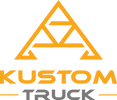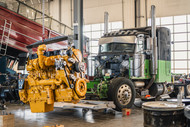Engine Conversion Basics: The 4 Pillars of a Flawless HD Truck Swap
Posted by Kustom Truck Parts on 30th Oct 2025
What's it take to complete an Engine Conversion
Engine swaps in heavy-duty trucks are the ultimate power move—whether you're repowering a fleet rig, restoring a legacy hauler, or upgrading for better fuel economy and emissions compliance. But success isn't about horsepower alone.
Overlooking one of the 4 categories can lead to unnecessary stress associated with the increased expense for parts not originally accounted for, additional down time to fabricate or order (if possible) the necessary missing parts.
No matter the truck (Peterbilt, Kenworth, Freightliner, Western Star) or engine (Cummins, CAT, Detroit, Paccar), four universal categories demand attention:
- Electronic Interface
- Piping Kits
- Brackets & Mounts
- Engine Upfit
Below, we’ll unpack what each includes, why it’s non-negotiable, and real-world pitfalls we’ve seen in shops nationwide.
1. Electronic Interface: Where Modern Trucks Live or Die
Modern HD trucks don’t just run on diesel and steel—they run on data. The new engine must speak the same language as your chassis, transmission, ABS, dash cluster, and cab computers.
Core Components:
- Engine-to-Cab Harness – The data lifeline between engine and dash
- Throttle Position Sensor (TPS) & Pedal Assembly – The TPS is engine family specific, even model specific in certain situations
- Charge/Start Harness – Powers alternator and starter, supplies main cab/sleeper power through a distribution center, and provides a main start circuit with a start relay
- Fuse Harness - Provides fused ECM power
- Automated Transmission Harness (if applicable) - Compatible Transmission to Engine and Cab communication
Why It Matters:
A mismatched or incorrect harness = potentially hours of downtime to troubleshoot the issue because gauges or switches are not functioning properly.
Pro Tip: The most often overlooked step in an engine conversion is ECM configuration. Even if the replacement engine is identical but came out of a different truck, the ECM still needs to be configured for the chassis it is being installed into.
2. Piping Kits: Water Circulation, Cold Air In, Heat Out
Engines don’t live in a vacuum—they need cold air in, heat out and the exhaust properly configured. Miss the fact that a CAT 3406E has a 6" turbo inlet diameter and a 5" turbo outlet diameter compared to the 4" inlet/outlet on your Cummins engine and it's back to the drawing board for using your existing Air Intake/Exahust pipes.
The Four Piping Zones:
| Zone | Function | Key Parts |
|---|---|---|
| Charge Air Cooling (CAC) | Turbo → intercooler → intake | Silicone CAC boots, hard pipes, CT (Constant Torque) Clamps |
| Radiator/Water Tubes | Engine → radiator/cooling package | Silicone hose, hard pipes, CT Clamps |
| Intake Air System | Air cleaner → turbo inlet | Intake Tube, Elbows, Bellows, Clamps |
| Exhaust Routing | Turbo outlet → muffler inlet | Turbo outlet elbow, downpipe, flex joints, stabilizer brackets |
Why It Matters in Engine Conversions:
- Cooling Package Changes = existing/donor truck pipes not compatible
- Air Intake Adaptation = turbo inlet diameter differences between engines
- Emission Components = only compatible with the engine they were developed for
Shop Story: An Owner-Operator swapped a 6NZ into his 2016 Peterbilt with a Cummins. Attempted to reuse CAC/RAD tubes from a 379 donor truck—tubes were correct at the engine but not the cooling package. $775 in machine work to modify the existing tubes + 2 days downtime.
3. Brackets & Mounts: Precision Alignment = Longevity
Brackets aren’t just metal—they’re the geometric foundation of your swap.
Must-Have Bracketry:
- Front & Rear Engine Mounts (engine side)
- Frame Rail Mounts (chassis side)
- Transmission Support
- Air Cleaner Brackets
Why It Matters:
- Engine too high? → Fan hits shroud
- Too far forward? → Firewall contact
- Engine to Chassis Mounts? → Compatibility Issues
Key Fact: Mounts are chassis specific, even model specific in certain applications.
4. Engine Upfit: The Most Overlooked Step
Unless the donor engine came from the same year/make/model of truck, a “running take-out” is never drop-in ready.
Common Upfit Needs:
- Belt Drive: V-Belts vs. Serpentine
- Fan Hub
- Accessory Location (Alternator & A/C Mounting)
- Intake Manifold Style/Orientation
- Turbo Outlet Elbow Clocking
- Thermostat Housing Orientation
- Oil Pan Configuration (Front or Rear Sump)
Why It Matters:
A Detroit Series 60 12.7L from a Freightliner has a different style of Intake Manifold than the same Series 60 12.7L from a Peterbilt.
The Fan Belt Trap
Belts are a system that requires precise alignment that work in unison with the cranksahft, fan hub and accessories (Alternator & A/C Compressor). Pulleys out of alignment by just 0.5° = thrown belts, downtime, unexpected replacement expense.
Your Kustom Truck Parts Engine Swap Checklist
| Category | Verify This | KTP Solution |
|---|---|---|
| Electronics | Generation of Chassis and Engine Electronics | ✅ |
| Piping | Turbo Inlet and Outlet Diameters, Turbo Elbow Style, Cooling Package | ✅ |
| Brackets | Front & Rear Motor Mounts, Chassis Brackets | ✅ |
| Upfit | Belt Type, Intake Manifold style, Fan Hub, Oil Pan Orientation | ✅ |
Final Word: Swap Smart, Haul Strong
Engine conversions are equal parts science and strategy. Skip the guesswork—one wrong bracket or harness can cost you weeks.
At Kustom Truck Parts, we’ve engineered application-specific swap kits for Peterbilt, Kenworth, Freightliner and Western Star truck platforms. No universal junk. No “close enough.”
Ready to Repower Your Truck? Call Now: 1-888-564-8890
Mon–Fri 8AM–5PM PST | Speak with a repower specialist

